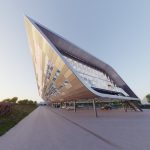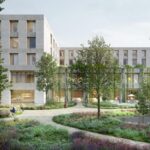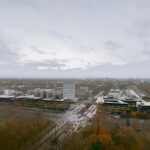Besucherzentrum Grube Messel Building, Germany landau+kindelbacher architecture image
Besucherzentrum Grube Messel
Visitors center and exposition “Zeit und Messel Welten”, Germany
3 Sep 2010
Visitors center and exposition “Zeit und Messel Welten”, Messel, Germany
Architecture: landau+kindelbacher, Munich
Scenography and Interior Design: Holzer Kobler Architekturen, Zurich
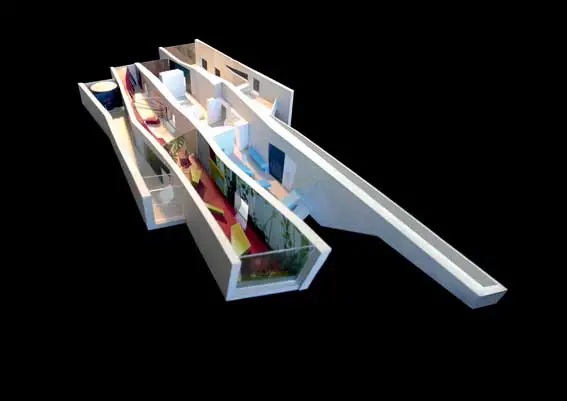
Grube Messel images © Holzer Kobler Architekturen
Scenography, exhibition architecture and interior design, Visitor Center Grube Messel, Messel (Hesse) Germany
2010
Zeit und Messel Welten
A crater measuring around 800 meters in diameter surrounded by woods, at its base a bare stretch of ground − in the Messel Pit near Darmstadt in central Germany, oil shale was mined for almost 100 years. Here very well preserved fossils were found again and again in the course of mining operations.
After the mine was closed in 1971 plans were made to convert the site into a garbage dump, but the population of the town of Messel was able to prevent this from happening. In 1995 the Messel Pit, where excavations are still being carried out, was placed under UNESCO protection as a World Heritage Site due to the great number of fossils that it contains.
The Visitors Center is located here. The layers of oil shale serve as the motif upon which the entire building design is based. The floor plan looks like a view of a cross-section of the rock, with long, parallel concrete walls representing the different layers. We’ve extended this spatial concept to the interior design, so that in walking through the exhibition visitors symbolically penetrate through four layers of rock.
Every room layer is subdivided by transverse glass walls into multiple, individually designed exhibition rooms. Crystalline shaped showcase units, interior constructions that resemble blocks of stone, and a large curved surface that resembles the acclivity of a crater wall are wedged in between the parallel walls like fossils or sediments. The interior elements are made to contrast with the exposed concrete architecture by means of their colorful forms.
In the foyer visitors can already begin learning about the mine. The tour of the exhibition itself begins in the Landschaft (Landscape) room with the story of the creation of the Messel Pit. A short film exploring the many different aspects of the site is then shown in the theater. Afterwards visitors are taken on a virtual ride into the depths of the pit − a kaleidoscopic journey in time through the world of rocks. The tour of the exhibition continues along the 24- meter long original drill core, describing a trip through the different layers of rock, all the way to the layers of oil shale.
In the Eocene jungle visitors are immersed in a sultry, shimmering world, created by means of moving pictures and sounds. The way to the exhibition’s center piece, the vault, leads through the Evolution room. In the vault itself original fossils are presented as valuable treasures from the pit. These witnesses to a world now ossified leave a lasting impression.
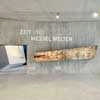
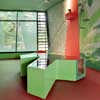
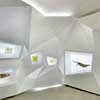
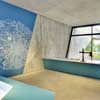
bilder © Holzer Kobler Architekturen, fotografie: Jan Bitter
The “Zeit und messel welten“
(Time and the Worlds of Messel) exhibition
The Messel Pit, since 1995 a UNESCO world natural heritage site, is of extraordinary importance for its fossils, which offer information about the Eocene era unique the world over.
The new Visitor Information Centre at the original excavation site puts this special place on show. It offers a glimpse at a long bygone era and uses sophisticated multimedia installations to plunge visitors into the heart of some of the earth’s treasures.
The one-of-a-kind construction by Landau + Kindelbacher of Munich echoes the layered geology of the pit with shear walls run through the entire building as stratifying elements. The exhibition concept, along with the overall scenography and interior design by Holzer Kobler Architekturen (HKA), is adapted to the non-orthogonal architecture of the structure. HKA, an internationally renowned Swiss firm of architects and exhibition designers, are known for Nebra Ark, among other projects. The building’s architecture, with its room-sized fixtures, is extended like a bizarre petrified landscape over the exhibits themselves, which in turn have been staged as installations by iart interactive, of Basel, internationally known for their projects fusing media, art and technology. The mood is set by silhouette-like illustrations towering several metres in height, produced by Visual Dope®, the successful Zurich Agency for Creative Goods also responsible for the Centre’s colour, form, font and signage.
Die Ausstellung „Zeit und Messel Welten“
The exhibition design is intended to provide information about the Messel Pit and its valuable fossil finds in a playful manner. Furthermore, without losing sight of solid facts or sacrificing the scientific foundation of the work, the exhibition aims to create an interactive atmosphere and use a range of objects to convey the powerful role of evolution in the shaping of life, ours and the world’s in general. Visitors gain greater insight into natural phenomena, whet their appetite for scientific inquiry and learn just how crucial for our present is the investigation of the past. “Zeit und Messel
” addresses academic research so as to render it more palatable to a lay audience, thus allowing science and culture to cross-pollinate.
Exhibition concept
Visitors take a symbolic tour of four substrata: each “layer” of the exhibition space is transected by shear walls into several subdivisions, each with its own design. Packed between parallel verticals like fossils are crystalline display cases, a massive, curved surface reminiscent of a crater wall, and internals in the form of boulders, the latter distinguished from the surrounding exposed concrete architecture by their colourful shapes. In the lobby of the Visitor Information Centre a dynamically illuminated light box attracts viewers to an atmospheric installation: an artful image of the oil shale so key to the Messel Pit. The first of the exhibition spaces, “Landscape”, addresses the genesis of the pit, while the Centre’s cinema boasts special footage created on location and presented as a feature film.
The space devoted to all things volcanic places visitors at the lip of what appears to be a live one, while a 360° projection simulates drilling down to 433 metres and offers a virtual “voyage to the centre of the earth” as well as a kaleidoscopic trip in time back to the Paleolithic era. Once they have arrived in the bowels of the earth, visitors can “step out” for a stroll along 24 metres of original core sample and walk down the various strata until they get to the celebrated oil shale. In the Eocene-era jungle they find themselves in a delightfully strange world, filled with all sorts of (virtual) flora and fauna, cast back in time to when the Messel Pit was still a crater lake, and the eohippus, ancestor of our horse, not yet extinct.
The walls of the entire space are covered in giant, silhouette-like illustrations across which a variety of technical systems project moving images of beasts whose fossilized forms are elsewhere present in the exhibition: eohippuses, lemurs and a swarm of bats, at set times depending on their diurnal and/or nocturnal rhythms.
The “Zeit und messel welten“
(Time and the Worlds of Messel) exhibition
In the next room, these same animals, as well as a range of prehistoric fish species, are used to tell the story of evolution, as they develop over millions of years to the ancestors we know today. The heart of the exhibition is the treasure chamber. To be found at the very end of the tour, it features original fossil finds, the crown jewels of the Messel Pit, including a crocodile, a turtle, and various fish.
As they tour the Information Centre, visitors are treated to two basic types of installations:
specially designed fixtures like the dynamically illuminated light box, the 360° projection and the multimedia rain forest, and frontal teaching aids such as interactive info posts, a cinema and video stations, all making classical use of the viewing screen.
The exhibition graphics are wholly devoted to the formal continuation of the construction’s non-orthogonal architecture, as if it were the most normal thing in the world, by way of the exhibits themselves, the font orientations, and the screen design, among other things.
The colour concept, inspired by the natural variety of the stone strata, contrasts with the exposed concrete of the architecture. Giant vector illustrations devoted to such topics as the rain forest or volcanoes, applied directly to the exposed concrete walls with negative stencils to a height of six metres, convey a mood as appealing as it is sophisticated, with fresh surprises in ever room further enhanced by the projections and the architecture itself.
Facts and Figures
Exhibition space
incl. lobby and bistro: approx. 930sqm
Competition: Dec 2006
Planning period: 2006-09
Building period: Feb 2010 – Aug 2010
Project Data
Planning:
Holzer Kobler Architekturen
Project team: Barbara Holzer, Annett Landsmann, Katharina Weistroffer,
Roland Lehnen, Kai Hellat, Martin Lüthy
Overall scenography, exhibition architecture and interior design:
Holzer Kobler Architekturen
Media and lighting planning:
iart interactive ag
Illustration, graphics and signage:
Visual Dope AG
Grube Messel images / information from Holzer Kobler Architekturen
Location: Messel, Germany
Architecture in Germany
German Architecture
German Architectural Designs – chronological list
NION Frankfurt am Main office building, Frankfurt, Hesse
Design: UNStudio
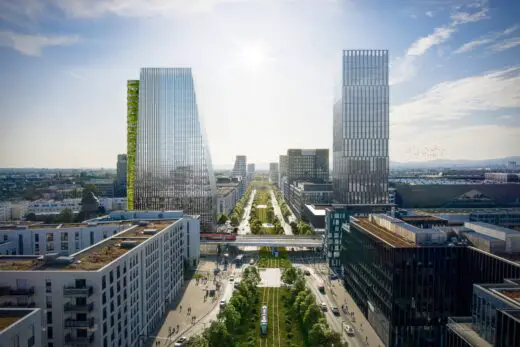
image : MOARE
NION Frankfurt office building
BORA, Herford, East Westphalia
Design: LORENZATELIERS
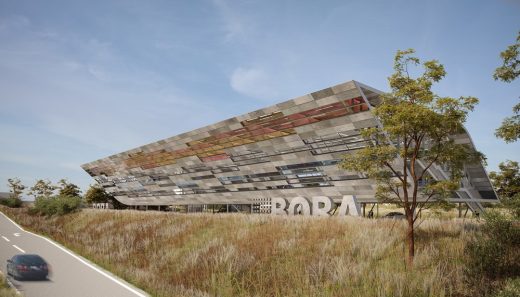
image courtesy of architects practice
BORA Building, Herford, East Westphalia
Innovation Park Artificial Intelligence, Heilbronn, Baden-Württemberg, south west Germany
Design: MVRDV
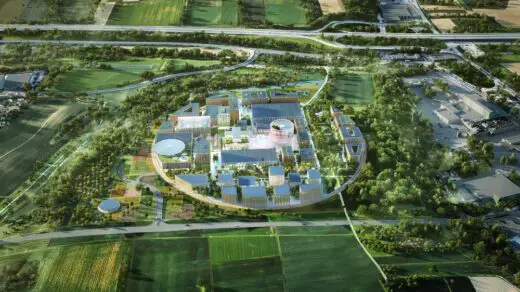
render © MVRDV
Innovation Park Artificial Intelligence Heilbronn
German museum building : Folkwang Museum, Essen
Comments / photos for the Besucherzentrum Grube Messe building page welcome

